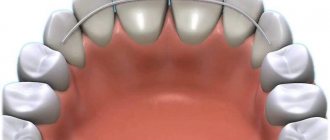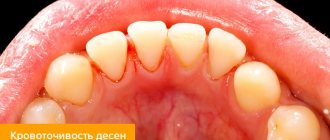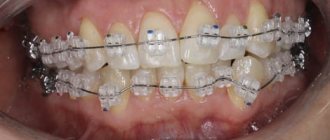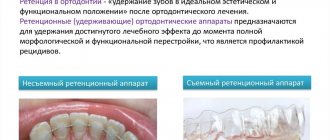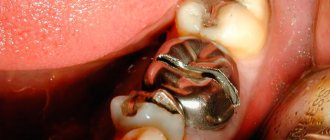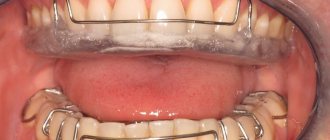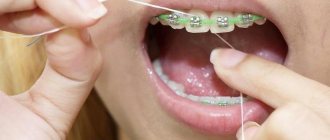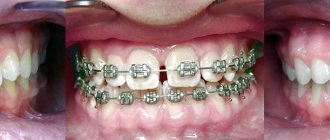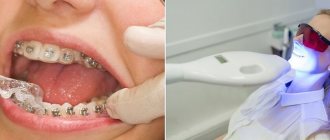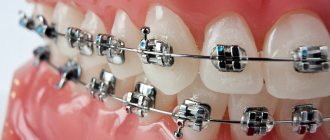Look at the smile in the photo. Do you notice anything strange? She’s kind of exhausted, tense... And it’s not surprising, because with braces you can’t smile much, because it hurts
.
After an orthodontist has placed braces on a patient, discomfort or even pain may occur. Is this normal? What to do if the pain does not go away or what should the patient do to reduce pain? And how can you avoid these rather unpleasant sensations? Let's figure it out.
It will be immediately important to note that sore teeth and gums after installing a brace system is, from the point of view of doctors, normal. It cannot be otherwise, because physical pressure begins to be exerted on the teeth, they begin to change their position - which, of course, at the first stage causes discomfort. Usually, most patients get used to these sensations; moreover, for the sake of a beautiful smile, one can endure temporary inconveniences.
And why, what pains will you go to to make your smile beautiful, right? )
So,
How can a patient feel after having braces installed?
How painful the sensations will be in the first days after the start of orthodontic treatment largely depends on the individual characteristics of the patient. Some may experience only mild discomfort from the device in the mouth, while for others, on the contrary, the pain can be so severe that it prevents them from falling asleep.
What a patient may encounter after installing braces:
- Burning sensation in the gums
. This is due to the fact that the tooth, changing its position, slightly injures the soft tissues. It's similar to when a tooth breaks through the gum. Everyone has experienced this feeling at some point.
- Pressure on teeth
. Usually it does not cause severe discomfort and the patient gets used to this effect. At first the pressure is stronger, gradually it subsides and intensifies again when the arc changes.
- Sharp sharp pain
. This can occur if you put too much pressure on a tooth that has braces installed on it. Such exposure usually causes cheekbones to tighten and tears to appear in the eyes. But such pain goes away immediately if you stop putting pressure on the tooth.
- Mild pain of unknown origin
. It usually appears in the first day after installing braces and can last for a long period. It most likely occurs due to fatigue in the oral cavity due to the pressure exerted by the orthodontic apparatus.
- Unpleasant sensations on the inside of the cheek
. This is due to the fact that braces rub against mucous membranes and can scratch them.
Again, experiencing some discomfort and pain immediately after installing braces is normal from the point of view of orthodontists. But it is abnormal and unnatural from the point of view of any realistically thinking patient. But in this case, there is no choice, and if the pain is severe and does not subside, then, most likely, the braces are installed either incorrectly and you should urgently consult a doctor, or you need to be patient (but also consult your doctor first).
Tip 2: use medications
Almost everyone has painkillers in their medicine cabinet. Ketarol or Nimesulide are perfect. Take the medicine as directed. As for medications, you can use the following:
- Use antiseptic liquids, for example, Miramistin spray. Treat your teeth three times a day.
- Buy special wax that helps you get used to braces. Apply it to the areas where there is pain.
- Dilute the Furacilin tablet in a glass of warm water. Rinse your mouth morning and evening for 5 minutes.
Why pain in braces is “normal”
Painful sensations tell us that the tooth is being impacted. This is how it moves. This process involves both soft gum tissue and the bone base of the jaws.
And if soft tissues easily adapt to the new position of the tooth and heal quickly, then bone tissues cannot change so quickly and hurt longer.
It is important to understand that this pain is not associated with the destruction of the tooth, but with its movement to a new, even position.
Interaction with the iron ligature of braces can also cause small ulcers in the mouth that irritate. Such irritation and even damage to the mucous membranes is caused by the metal parts of the brace system. These wounds go away quite quickly after the oral cavity adapts to the device. But they may not pass, as for example in this case:
We can say that the mucous membrane adapts to such external effects of metal. As they say, everyone has to get used to and come to terms with the fact that now they will have to wear braces on their teeth for a year or two.
Tip 3: new aspects in hygiene care
After the orthodontic structures are installed, it is best to purchase a gentle paste that is suitable for sensitive enamel. To start, use a soft-bristled brush. After final adaptation, you can return to a medium-hard brush. Brush your teeth as carefully as possible, do not press too hard on the brush.
You should also purchase a good mouthwash. It is better to choose a product designed for weak gums and sensitive enamel. Use a mouthwash after every meal.
How long will your teeth hurt after getting braces?
An eternal question that interests everyone without exception. At such moments, issues of weather, air temperature and sea water fade into the background. Because in the foreground is PAIN
. The duration of pain depends on the patient's sensitivity to pain. According to average statistics, all unpleasant sensations disappear within one to three days after installing the system.
If the patient has developed hypersensitivity and the pain lasts longer, then painkillers are prescribed.
Damage to the mucous membrane, after eliminating all problems, usually heals within one week or even earlier.
Types of designs and their differences
There are several types of retainers for teeth after braces . It is better to choose the most suitable one together with your doctor. Devices can be classified by size and type of material, but the classic basis for dividing products into groups is the ability to independently remove the simulator. So, there are fixed and removable retainers . Each type has its own characteristics and advantages.
Fixed retainers
Models that cannot be removed are more popular, so first you should understand what it is - a non-removable retainer . The device is a small fixing wire that is attached to the inside of the teeth. It is installed by the doctor immediately after the braces are removed.
The non-removable structure is almost impossible to see
There have been many studies on the effect of wire on teeth . Most dentists agree that the product is absolutely safe for enamel. It is attached with a special composite material and practically does not interfere with the patient.
On average, after the installation of retainers , a week must pass for the patient to stop noticing them. The only inconvenience he faces is the need for more thorough brushing of his teeth. While wearing it, it is recommended to use a special irrigator with an attachment that provides more thorough oral care.
Removable structures
A removable retainer is also called a “retention mouth guard.” At its core, the device is the same aligner with a metal arch, which does not need to affect the bite. Unlike removable systems, such systems require diligence and pedantry from the patient: it is necessary to strictly follow the doctor’s instructions, wear the products for the prescribed time, day and night.
Often, a removable retainer becomes an addition to a fixed model. Then it is worn overnight and removed for the day, but the wire remains on the teeth for 24 hours. Such measures are necessary if the doctor notices very strong bite resistance or if the wire is not effective enough for some molars or incisors.
Removable retainers are easy to put on but still noticeable on the teeth.
There are two types of removable retainers after braces :
- for both jaws. They are usually prescribed to be worn during the night, since such designs do not allow talking or drinking;
- retainers on the upper jaw or lower jaw - as necessary. Such models can be prescribed instead of a non-removable device, then they will have to be worn more often.
If non-removable models require the patient to spend time thoroughly cleaning the oral cavity, then when wearing removable ones, you may notice that this dental retainer requires more attention and care. It is advisable to regularly rinse and clean it according to the manufacturer’s instructions.
Another type of removable retainer. It is used less often, because hard elements harm the teeth and are very noticeable.
In some cases, the doctor gives preference to newer means - trainers. Read more about them in a separate article: Trainers for teeth straightening: description, varieties, tips for use...
What will help you cope with pain?
If you follow all the doctor's recommendations and properly care for your teeth and braces, pain may not occur at all, only some discomfort.
If the pain does not go away, then it is worth checking how the braces are installed; perhaps some mistakes were made that only a doctor will correct.
What other recommendations might there be for patients experiencing pain in braces?
- Dietary restrictions - switching to liquid and pureed foods. - How do you like this option?
- Treatment of braces with dental wax.
- Take painkillers only as prescribed by a doctor!
Diet restrictions
If you have braces, be prepared to change your diet and avoid foods that are hard, fibrous, or too hot or cold. Because this can break your braces, damage your teeth, or increase pain.
After installing the system, you should wait at least one hour before you can eat liquid or soft food. Soups, pureed porridge and even baby food are the basis of your diet during bite correction. And, by the way, you will have to brush your teeth very, very carefully, since food will constantly get stuck there, forming plaque:
Special wax
In pharmacies you can buy orthodontic wax, which is applied to braces and helps reduce pain from friction and pressure of the device on the mucous membranes and teeth.
Taking painkillers
Any medications, even the seemingly safest ones, should be used only after consultation with a specialist and after carefully reading the instructions, contraindications and side effects of these medications. By mindlessly taking any medications, you can only seriously harm yourself, always remember this!
For irritation of the mucous membrane, rinsing with chamomile decoction helps a lot. Of course, with one “but” - if you are not allergic to it.
CONCLUSION
: In case of any incomprehensible sensations, we recommend that you contact your doctor so as not to miss serious points during treatment.
We still have one important question, which we promised to answer at the very beginning of the article, here it is:
Tip 1: Adjust your diet
The “peak” of pain will be observed in the first three days after the installation of braces. In order to reduce discomfort, experts recommend eating only liquid foods. An excellent option would be cream soup, porridge, vegetable purees, etc. After a couple of days, as the pain subsides, you can gradually include solid foods in your diet. Also follow these rules:
- If the pain is unbearable, you can suck on an ice cube; the cold will help reduce discomfort.
- Avoid sour and sweet foods.
- Drink more water.
How can you avoid pain with braces?
ANSWER: Very simple - aligners. A - not braces. This should be your normal choice for correcting your bite. Aligners have long proven to everyone - both doctors and patients - that they have a huge number of advantages over braces.
And with aligners, you don’t need to be afraid of pain for the simple reason that there is NO pain there.
When to see a dentist
To effectively straighten your teeth, you should regularly tighten your braces. You must visit the doctor every month. In difficult cases, this is done every 2 weeks. Self-ligating braces allow you to visit the dentist once every 2 months.
To get a beautiful smile, you need to follow all recommendations and visit dentists at every opportunity.
If you have not yet chosen your braces system, contact our dentists. We have qualified orthopedists and the most attractive prices for braces. Sapphire braces, metal, ligature-free and many others - you can discuss each option with your doctor, choosing the best one!

